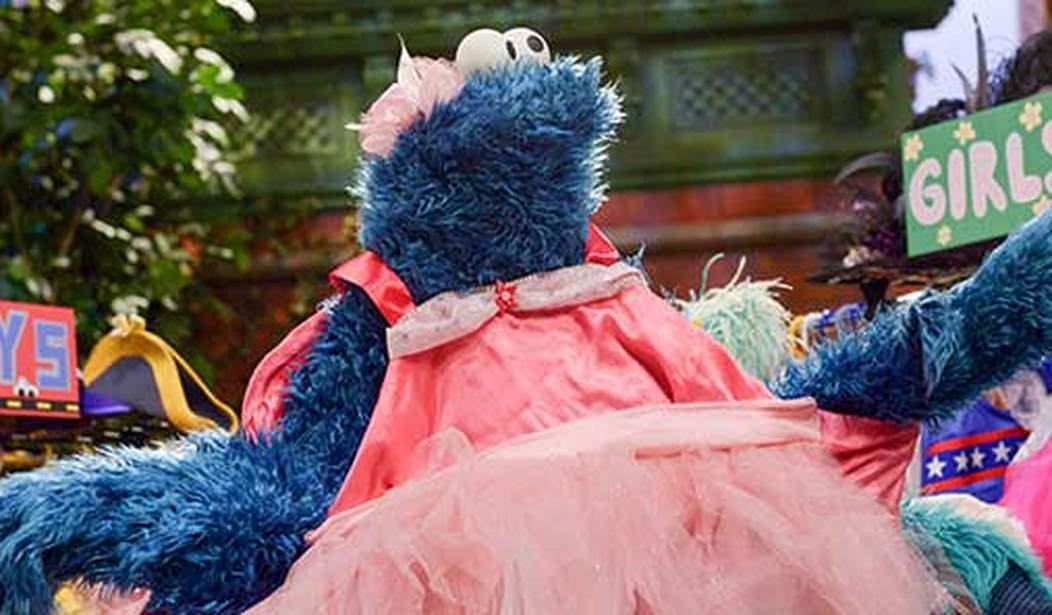Watching television with your children is a great way to learn about their likes and dislikes and what resonates with them. For example, the other day my son wasn’t feeling so great, so I declared it a pajama day. After some rather unenthusiastic play, he grabbed his favorite Curious George stuffed animal and headed for the couch, his way of telling me he just wanted to zone out and cuddle. I complied and we tuned into Sesame Street.
My son quickly went from relaxed to confused. His brow furrowed as a series of puppets including Elmo, Abby, Cookie Monster and Grover got into an argument over how boys and girls could play dress-up. The narrative, a dress-up club on Sesame Street, was quickly lost amidst the puppets talking over one another about how boys and girls should play dress-up. One puppet kept screaming that girls needed to be princesses while boys needed to be superheroes. Grover and Elmo suddenly wanted to play tea party and then, Cookie Monster burst onto the scene in a tutu declaring himself to be a ballerina.
At that point my son was so confused and I was so irritated that I flipped over to an episode of Cat in the Hat I’d left on the DVR for a rainy day. Instantly he lit up, sat up and grew ensconced in the narrative. He was so excited about Nick and Sally’s adventure with the Cat to study amoebas in drops of water that he soon slid off my lap to get closer to the TV, smile and dance along.
There are a number of lessons to glean from this TV viewing experience. Firstly, even at 16 months old a child can follow a narrative. When the basic story is lost, the child quickly loses interest. In their zeal to infuse gender politics into a story about playing dress-up, Sesame Street lost the attention of their target audience. Kids don’t want to be told what to do. They want to be shown how it’s done.
Secondly, more children, boys especially, are going to be drawn away from the liberal arts and into the world of STEM (Science, Technology, Engineering and Math). Boys are practical, logical learners. Shows like the Cat in the Hat and Curious George use a logical narrative structure that involves problem solving with a STEM-related topic. While the girls on Sesame Street argue over what it means to be a girl, the boys will be busy with the Cat in the Hat exploring single-cell organisms, or working with Curious George to build an igloo at the farm. Critical, creative thinking in order to solve real-world problems using science, technology, engineering, and math. How logical is that?
The third lesson I learned is the most frightening to me. Not only are the liberal arts being stolen by this gender and sexuality obsession, but now imagination is as well. The goal of the Sesame Street dress-up club is to dress up in order to pretend fantasies. Telling girls they can be superheroes and boys that they can enjoy tea parties is nothing new or remarkable. Pick up a comic book and you’ll find a female superhero. Look around the world and you’ll find plenty of men drinking tea. But, when have you ever seen a male ballet costume featuring a tutu?
The history of dance has taught us that men can be dancers, even on a professional level, and still embrace their masculinity. Moreover, men do not need to cross-dress in order to dance, because dancing is not an engendered talent. By putting Cookie Monster in a tutu, Sesame Street turned dressing up into cross-dressing. And as happens often in the realm of gender and sexuality studies, male sexuality became a direct target for attack and feminization. Where is the freedom of imagination in that?
The overarching lesson of dress-up club on Sesame Street is that Children’s Television Workshop has clearly lost touch with its target audience. Kids are going to dress up however they want without any help or intervention from any media outlet. Contrary to popular opinion, children do have minds of their own. The real target audience of this episode is parents. Hence the TV Guide review of this particular episode ends with, “Though Sesame Street is clearly aimed at children, this is an episode that some adults could benefit from seeing as well.” Why? Because retailers are suddenly making toy aisles gender-neutral, or because politicians and school boards are passing laws against gender-oriented bathrooms? In other words, Sesame Street doesn’t really care about your kid’s imagination at all. They care about your level of political correctness as a parent. They care that you’re raising your child, not to think critically or creatively, but to go with society’s flow.









Join the conversation as a VIP Member